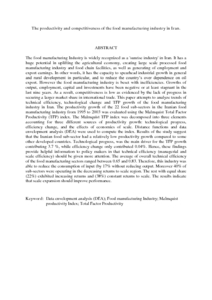Citation
Ismail, Mohd Mansor and Mohamed, ZainalAbidin and Torghabeh, Majid Sanaei and Tavakoli, Hossein
(2010)
The productivity and competitiveness of the food manufacturing industry in Iran.
Middle-East Journal of Scientific Research, 5 (4).
pp. 245-251.
ISSN 1990-9233
Abstract
The food manufacturing Industry is widely recognized as a 'sunrise industry' in Iran. It has a huge potential in uplifting the agricultural economy, creating large scale processed food manufacturing industry and food chain facilities, as well as generating of employment and export earnings. In other words, it has the capacity to spearhead industrial growth in general and rural development in particular, and to reduce the country’s over dependence on oil export. However the food manufacturing industry is beset with inefficiencies. Growths of output, employment, capital and investments have been negative or at least stagnant in the last nine years. As a result, competitiveness is low as evidenced by the lack of progress in securing a larger market share in international trade. This paper attempts to analyze trends of technical efficiency, technological change and TFP growth of the food manufacturing industry in Iran. The productivity growth of the 22 food sub-sectors in the Iranian food manufacturing industry from 1995 to 2003 was evaluated using the Malmquist Total Factor Productivity (TFP) index. The Malmquist TFP index was decomposed into three elements accounting for three different sources of productivity growth: technological progress, efficiency change, and the effects of economies of scale. Distance functions and data envelopment analysis (DEA) were used to compute the index. Results of the study suggest that the Iranian food sub-sector had a relatively low productivity growth compared to some other developed countries. Technological progress, was the main driver for the TFP growth contributing 3.7 %, while efficiency change only contributed 0.04%. Hence, these findings provide helpful information to policy makers in that technical efficiency (managerial and scale efficiency) should be given more attention. The average of overall technical efficiency of the food manufacturing sectors ranged between 0.65 and 0.83. Therefore, this industry was able to reduce the consumption of input (by 17% without reducing output. Moreover 40% of sub-sectors were operating in the decreasing returns to scale region. The rest with equal share (22%) exhibited increasing returns and (38%) constant returns to scale. The results indicate that scale expansion should improve performance.
Download File
![[img]](http://psasir.upm.edu.my/17282/1.hassmallThumbnailVersion/The%20productivity%20and%20competitiveness%20of%20the%20food%20manufacturing%20industry%20in%20Iran.pdf)  Preview |
|
PDF (Abstract)
The productivity and competitiveness of the food manufacturing industry in Iran.pdf
Download (187kB)
| Preview
|
|
Additional Metadata
| Item Type: |
Article
|
| Subject: |
Food industry and trade - Iran. |
| Subject: |
Food industry and trade - Technological innovations - Iran. |
| Divisions: |
Faculty of Agriculture |
| Keywords: |
Data envelopment analysis (DEA); Food manufacturing Industry; Malmquist productivity Index; Total Factor Productivity |
| Depositing User: |
Norhazura Hamzah
|
| Date Deposited: |
22 May 2012 05:15 |
| Last Modified: |
29 Sep 2015 01:38 |
| URI: |
http://psasir.upm.edu.my/id/eprint/17282 |
| Statistic Details: |
View Download Statistic |
Actions (login required)
 |
View Item |

